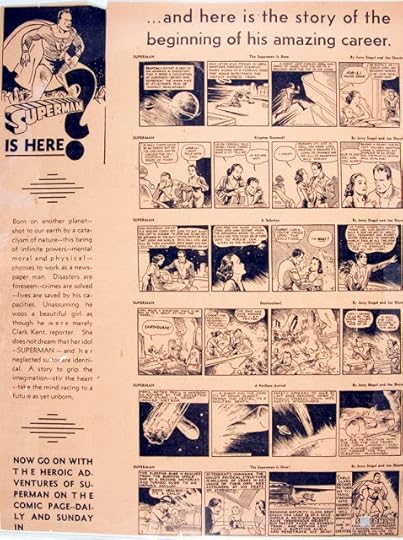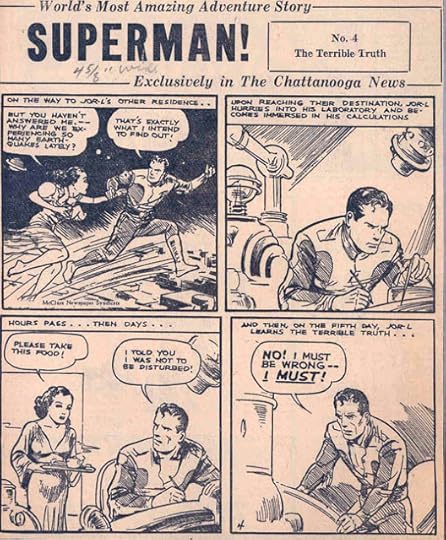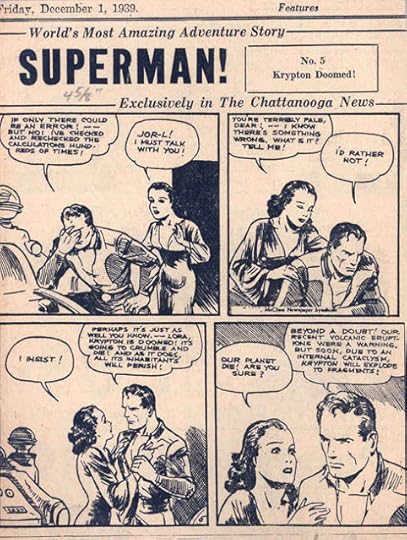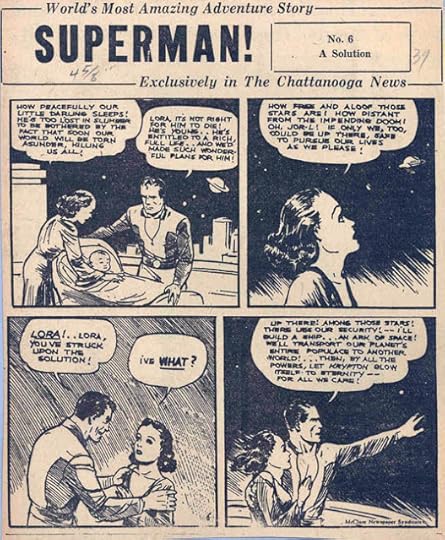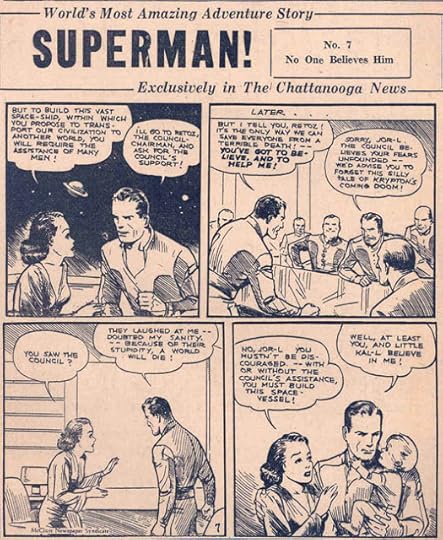Jim Shooter's Blog, page 7
November 4, 2011
How to Do Continued Stories and Next or Future Issue Teases – Part 3
The Great Cover After the Best Cliffhanger Ever
At the request of Lincoln G, here's the cover of the Amazing Spider-Man #33. Not surprisingly, the best cliffhanger also made for a terrific cliffhanger cover.

Long Term Teases, or This Better Be Good….
The best long term tease, the best tease of any kind is consistently great entertainment. Publishing compelling issue after compelling issue is the best way to keep people interested in what comes next. Build up enough momentum, enough reputation and even if the stories are not as good as usual for a multi-issue stretch, the audience will stick with a series for a while. It's like a ride in a hot air balloon. You stay aloft for a while even after the burner is turned off.
I know you can think of lots of examples of the above.
So, besides being brilliant issue after issue, what can you do on a long term basis to entice people to stick around for future developments? Here are some techniques:
Slow Builds and Subplots
The slow build is cousin to the dramatized next issue blurb discussed last post. It's a series of scenes unrelated to the story in the issues in which they appear that build anticipation of a story or Big Event to come some issues down the road. It usually goes something like this:
In an issue of the Fantastic Four (for instance) in which they're dealing with the Super-Skrull, we cut to Doctor Doom's laboratory in Latveria as he's making an ominous scientific breakthrough. In the process, in very few words, we get across the essential info about Doom, that he's smart and not nice. Uh-oh.
In a subsequent issue, in which the FF are battling the Frightful Four, we cut to Latveria again. Again, succinctly and elegantly we get across the essentials about Doom, plus the fact that he has discovered some frightening power. We look on with terror as he builds his Cosmic Pinwheel! That's gonna be trouble…!
Etc.
Once we've built the anticipation to epic intensity, we pay it off with the Doctor Doom Cosmic Pinwheel Saga.
Those of you who have more comics easily at hand than I do can probably find many examples. One slow build I can think of, off the top of my head, that led to a Big Event rather than a story, was the slow build toward revealing Mary Jane Watson's face in Spider-Man. I believe the first partial look at Mary Jane came in Spider-Man #25. After several slow build scenes along the way, we finally see what she looks like in #42: "Face it, Tiger…you just hit the jackpot!"
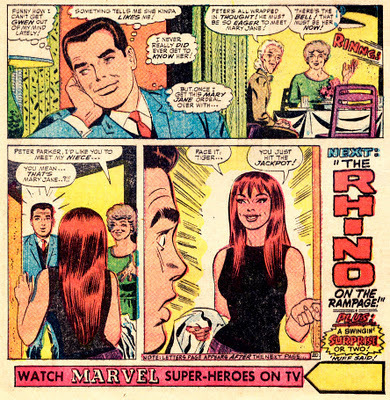 The above is different than a subplot. A subplot is related to the main plot of the story and is resolved at the same climax as the main plot.
The above is different than a subplot. A subplot is related to the main plot of the story and is resolved at the same climax as the main plot. An example of a subplot: In the movie Rocky, the main plot is the story of the fight. The principal subplot involves Rocky's inner conflict over his self-worth. People think he's nothing but an aging pug. Even he wonders if that's all he is. When the bell rings at the end of the fifteenth round the main plot is resolved—Rocky loses on points—and in that same moment, the ding of a bell, the subplot is resolved—he is still on his feet, something no one else has ever accomplished in a fight against the champ, and therefore he has proven himself worthy. He calls his girlfriend's name, all other threads are tied up. The end.
P.S. the champ says "no rematch," and Rocky says "I don't want one." Which, of course, doesn't prevent a slew of sequels. : )
An example of a subplot that serves as a long term tease that comes easily to mind because I was involved was in the Avengers, in the Korvac Saga. In issue #175, Moondragon becomes actively involved in the search for the Enemy. Immediately, and in high-handed fashion, she pontificates to the Avengers about things. In particular, she lectures Quicksilver, who had a prejudice against "artificial" beings (established by others and related to the fact that he was upset about his sister, the Scarlet Witch, marrying an android, the Vision). "…eternity is vast—and its definitions of life are many." Cosmic wisdom has she.
In the subsequent issue she disdains "…the self-righteous judgments with which you mortals soil your souls." Then, using her mental powers, she simply erases Quicksilver's prejudice!
 Hawkeye's reacts: "…where do you get off, baldy? Treatin' someone's mind like a…bathtub with a ring!" She's high-handed, indeed, and oh, so smugly superior. She treats the other Avengers as subordinates, even leader Iron Man.
Hawkeye's reacts: "…where do you get off, baldy? Treatin' someone's mind like a…bathtub with a ring!" She's high-handed, indeed, and oh, so smugly superior. She treats the other Avengers as subordinates, even leader Iron Man.
 (All dialogue quoted above written by David Michelinie.)
(All dialogue quoted above written by David Michelinie.)We also get a hint that she gains some flicker of awareness of the well-hidden Enemy.
At Moondragon's imperious insistence, the Avengers, who have been trying to detect the whereabouts of the Enemy using their powers, assemble and compare notes. A pattern emerges, as she knew it would. The Avengers find the Enemy hiding out in a modest home in Forest Hills.
A battle ensues. While the Enemy, who calls himself Michael, is distracted by the fight, Moondragon gets a glimpse into his mind…and is deeply moved by what she sees!
She does not join the fight!
At the climax, at the moment of victory, she reveals that what the Enemy/Michael had in mind for the universe was a sort of a benign dictatorship…not to "…interfere with our madness!" but "…only to free us from the capricious whims of eternity," i.e., bad stuff.
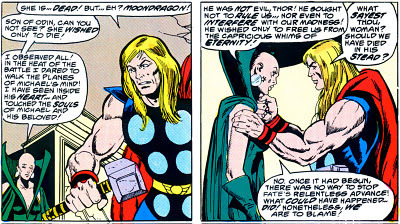 She judges Michael the good guy and the Avengers, unwittingly the bad guys who "…slew the dream…then the hope!"
She judges Michael the good guy and the Avengers, unwittingly the bad guys who "…slew the dream…then the hope!"But she would think that, wouldn't she…? Moondragon, who thought it was just fine to "fix" Quicksilver's mind. Her take on what happened is colored by her belief that it is okay for "superior" beings like herself to make things better for us lowlifes.
She wipes the Avengers' minds so all they will remember is a great victory. But she will remember what she thinks of as the tragedy they caused "forever…."
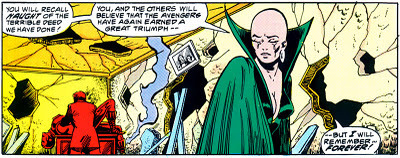 So, the subplot leads to a resolution for Moondragon at the same point that the main plot resolves, specifically that she has been changed by the experience. And might be up to something.
So, the subplot leads to a resolution for Moondragon at the same point that the main plot resolves, specifically that she has been changed by the experience. And might be up to something.If I had continued on the series, I would have soon thereafter brought that bird to roost. As it happened, it was some time before I got around to it, in issues #219 and #220, in which Moondragon, emulating Michael, simply takes over a war-torn planet, forcibly bringing about peace.
(ASIDE: In reprintings of the Korvac Saga, long after I was gone, editor Ralph Macchio had an idiotic "Epilogue" tacked on that destroyed the ending, which he obviously didn't grok. The Epilogue retroactively eviscerated the payoff of the Moondragon long term tease in issues #219-220, "…By Divine Right," and "War Against the Gods.")
Anyway….
A subplot can set up and tease a future issue.
Of course, you can do a combination of subplot teases and slow build teases. Anticipation for the revelation of the true identity of the Green Goblin involved both slow build scenes and subplots played out over many issues of Spider-Man leading up to the ending of #39.
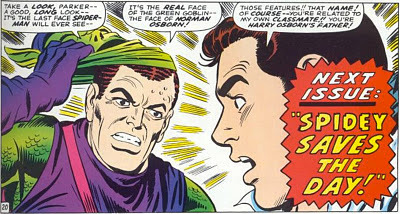 Another long term tease technique is the "Easter Egg." Drop a small hint, show a potentially interesting item, or plant a clue, but keep it incidental and, at first, seemingly unimportant.
Another long term tease technique is the "Easter Egg." Drop a small hint, show a potentially interesting item, or plant a clue, but keep it incidental and, at first, seemingly unimportant.For instance, in an early issue of Spider-Man, Aunt May needed a blood transfusion. Her nephew Peter, who had the right blood type, volunteered. At the time, he briefly wondered whether or not the radioactivity in his blood would affect her. And as a reader, I thought, oh, my God…! Aunt May gets spider powers?
Nah.
It seemed to be nothing…until the Master Planner Sequence, in which the radiation that affected Peter positively turned out to be harmful to Aunt May, slowly killing her, in fact.
When the Master Planner Sequence came along, I remembered the transfusion bit long before. And I loved the fact that I did.
Easter Eggs are the most subtle of long term teases. I hadn't been eagerly anticipating consequences of the transfusion, but when there were some, it helped to hook me even more on the series. It made it seem that everything mattered.
That's how Easter Eggs work. You start looking for them, start wondering about possible consequences and speculating.
Gerry Conway used to plant Easter Eggs all over the place, usually having no idea (he said) what he was eventually going to do with them. Someone leaves a valise at the train station. Wonder what could be in it? A scientist detects something unusual. A strange gem is among those heisted in a robbery…. Whatever. Somewhere down the road, the secret plans for the Cosmic Pinwheel would turn out to be in that valise. Etc.
Writers often merely find some item or event that was a natural part of a story some issues back and find a way to retroactively turn it into an Easter Egg. The pen with which Doctor Strange signed the UPS guy's receipt, an utterly incidental prop in a story about packages being switched turns out to now be charged by Strange's touch with the Insidious Ink of Ichabodius. Or something.
Lots of ways to create and sustain long term interest.
The important thing is this: If you're going to build up anticipation, suspense and high expectations, keep in mind that when the reader gets to the payoff, somewhere in the back of his or her mind, the reader is thinking, "This better be good!"
OVER THE WEEKEND: Thanksgiving in Newark
MONDAY: Ditko at VALIANT and DEFIANT
Published on November 04, 2011 13:04
November 3, 2011
Mark Twain's Rules of Literary Art
Excerpted from "Fenimore Cooper's Literary Offenses" by Mark Twain.
JayJay here. Over the years Jim has had a few classic sources of advice on writing that he would refer writers to. Here is one of them. Good things to keep in mind.
And I recommend reading the essay that these guidelines are taken from even if you have never read any Fenimore Cooper. It's very funny. Over the years Jim has had many people ROTFL when he performed dramatic readings of it. Makes my sides hurt to even remember.
The rules governing literary art in the domain of romantic fiction require:
That a tale shall accomplish something and arrive somewhere.They require that the episodes of a tale shall be necessary parts of the tale and shall help to develop it.They require that the personages of a tale shall be alive, except in the case of corpses, and that always the reader shall be able to tell the corpses from the others.They require that the personages in a tale, both dead and alive, shall exhibit sufficient excuse for being there.They require that when personages of a tale deal in conversation, the talk shall sound like human talk, and be talk such as human beings would be likely to talk in the given circumstances, and have a discoverable meaning, also a discoverable purpose, and a show of relevancy, and remain in the neighborhood of the subject in hand, and be interesting to the reader, and help out the tale, and stop when people cannot think of anything more to say.They require that when the author describes the character of a personage in his tale, the conduct and conversation of that personage shall justify said description.They require that when a personage talks like an illustrated, gilt-edged, tree-calf, hand tooled, seven dollar Friendship's Offering in the beginning of a paragraph, he shall not talk like a negro minstrel in the end of it.They require that crass stupidities shall not be played upon the reader as "the craft of the woodsman, the delicate art of the forest" by either the author or the people in the tale.They require that the personages of a tale shall confine themselves to possibilities and let miracles alone; or, if they venture a miracle, the author must so plausibly set it forth as to make it look possible and reasonable.They require that the author shall make the reader feel a deep interest in the personages in his tale and in their fate; and that he shall make the reader love the good people in the tale and hate the bad ones.They require that the characters in a tale shall be so clearly defined that the reader can tell beforehand what each will do in a given emergency.
In addition to the large rules there are some little ones. These require that the author shall:
Say what he is proposing to say, not merely come near it.Use the right word, not its second cousin.Eschew surplusage.Not omit necessary details.Avoid slovenliness of form.Use good grammar.Employ a simple and straightforward style.
JayJay here. Over the years Jim has had a few classic sources of advice on writing that he would refer writers to. Here is one of them. Good things to keep in mind.
And I recommend reading the essay that these guidelines are taken from even if you have never read any Fenimore Cooper. It's very funny. Over the years Jim has had many people ROTFL when he performed dramatic readings of it. Makes my sides hurt to even remember.
The rules governing literary art in the domain of romantic fiction require:
That a tale shall accomplish something and arrive somewhere.They require that the episodes of a tale shall be necessary parts of the tale and shall help to develop it.They require that the personages of a tale shall be alive, except in the case of corpses, and that always the reader shall be able to tell the corpses from the others.They require that the personages in a tale, both dead and alive, shall exhibit sufficient excuse for being there.They require that when personages of a tale deal in conversation, the talk shall sound like human talk, and be talk such as human beings would be likely to talk in the given circumstances, and have a discoverable meaning, also a discoverable purpose, and a show of relevancy, and remain in the neighborhood of the subject in hand, and be interesting to the reader, and help out the tale, and stop when people cannot think of anything more to say.They require that when the author describes the character of a personage in his tale, the conduct and conversation of that personage shall justify said description.They require that when a personage talks like an illustrated, gilt-edged, tree-calf, hand tooled, seven dollar Friendship's Offering in the beginning of a paragraph, he shall not talk like a negro minstrel in the end of it.They require that crass stupidities shall not be played upon the reader as "the craft of the woodsman, the delicate art of the forest" by either the author or the people in the tale.They require that the personages of a tale shall confine themselves to possibilities and let miracles alone; or, if they venture a miracle, the author must so plausibly set it forth as to make it look possible and reasonable.They require that the author shall make the reader feel a deep interest in the personages in his tale and in their fate; and that he shall make the reader love the good people in the tale and hate the bad ones.They require that the characters in a tale shall be so clearly defined that the reader can tell beforehand what each will do in a given emergency.
In addition to the large rules there are some little ones. These require that the author shall:
Say what he is proposing to say, not merely come near it.Use the right word, not its second cousin.Eschew surplusage.Not omit necessary details.Avoid slovenliness of form.Use good grammar.Employ a simple and straightforward style.
Published on November 03, 2011 14:42
November 2, 2011
How to Do Continued Stories and Next or Future Issue Teases – Part 2
The Best Cliffhanger Ever
I remember buying this comic book at Churchill's Pharmacy, corner of South Park Road and Brightwood Road, Bethel Park, Pennsylvania. It was October, 1965. I had just turned fourteen.
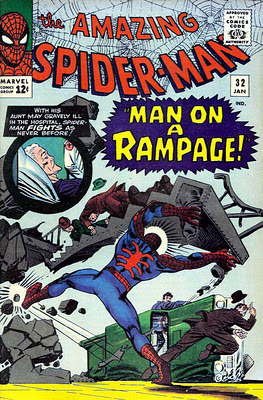 I read the book in the store, after paying for it. They were nice at Churchill's but like everywhere else, if you read the books before buying them, they'd remind you "this isn't a library."
I read the book in the store, after paying for it. They were nice at Churchill's but like everywhere else, if you read the books before buying them, they'd remind you "this isn't a library."The issue contained the second chapter of a three-part story, fondly referred to around Marvel in my day as the "Master Planner Sequence." This chapter, "Man on a Rampage," features Spider-Man on a desperate quest to recover the only thing that can save his beloved Aunt May's life, a serum called ISO-36, the only supply of which has been stolen by the Master Planner's thugs.
The Master Planner turns out to be Doctor Octopus. Spider-Man ends up battling Doc Ock in his underwater hideout. Spider-Man's desperate fury drives away Doc Ock, but their battle has so damaged the structure that, as Doc Ock flees, an immense piece of equipment topples over on Spider-Man pinning him under it.
He's trapped.
The container with the serum lies tormentingly in sight.
The dome overhead is breaking up. Water is rushing in.
There is no way out. No hope.
For me, that was the best cliffhanger ever:
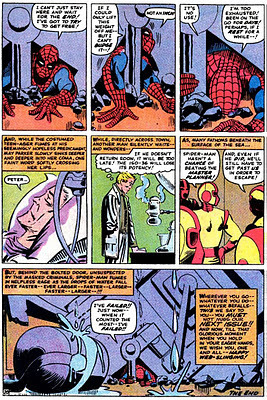 That's just me. I'm sure you have your own favorites. But I won't ever forget standing agape in Churchill's Pharmacy trying to process the realization that I'd have to wait an entire month to see what happened.
That's just me. I'm sure you have your own favorites. But I won't ever forget standing agape in Churchill's Pharmacy trying to process the realization that I'd have to wait an entire month to see what happened.As for the story, well, some would say it was amazingly coincidental that Doctor Octopus happened to need, and steal, the only thing that could save Aunt May. Stan did justify it to some extent, though. Aunt May was dying because of radioactivity in her blood. Her blood was contaminated by a transfusion of nephew Peter/Spider-Man's radiation-altered blood. Like Spider-Man, Doctor Octopus gained his powers from radiation. It is not an inconceivable stretch that he'd be interested in a serum that affects radioactivity in the blood.
Yeah, I know, it's still a coincidence.
But as I often say, you have to look at those early sixties stories in the context of the times. Back when Superman's main problem seemed to be keeping Lois from guessing his secret identity, the emotional content of the Master Planner Sequence was stunning.
So Stan did that leg of a three-part continued story in the "normal" way, generating powerful conflicts, building to a climax/cliffhanger and breaking there. "As seen on TV," you might say, since that's the technique employed almost exclusively by usually-one-part TV dramas that have a special two-parter. It was/is the standard even for sitcoms.
And the pay-off was great:
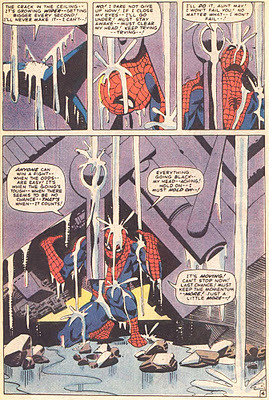 [image error]
[image error]
Baiting the Hook
As noted yesterday, there are many ways to do multi-issue or continued stories. Not all involve a climax/cliffhanger.
If you don't have that how am I going to wait a whole month to find out what happened cliffhanger? to bring the readers rushing back, how do you do it?
Lots of ways.First, and ultimately the most important, nothing makes a reader more inclined to pick up the next issue than if the book they just read is great. That's the mightiest hook you can sink.
If the book in hand is terrific, other kinds of teases may not be needed, but won't hurt. If the book in hand is, perhaps, good, but not the greatest issue of all time, teases may help.
If the book in hand is bad, well, probably nothing you can do will work. But, if the teases are really compelling, at least there's hope that the reader will give you one more chance.
The simplest tease is the next issue blurb. Even if it's just the title, if it's a really compelling title, that can stir interest.
I've know I've written a few good titles along the way. I can't think of any right now. Maybe they weren't that good.
Aha! I came up with one for Legion of Super-Heroes #42, in which the Legionnaires are in terrifying danger but have gotten new, protective costumes: "Fear and Clothing."
Well, I liked it. And the editor laughed out loud.
Ahem.
Anyway….
Some little hint about the must-see events that will occur in the next issue is good, too. At the end of Amazing Spider-Man #31, Stan wrote:
"Next issue: We shall learn the fate of Peter Parker's Aunt May, as well as the identity of – the Master Planner!"
Okay.
The next level of tease is, essentially, a dramatization of the next issue blurb/hint about must-see things in store—a page, a few panels or a single panel that plays out a dramatic development that affects next issue. In addition to his next issue blurb, Stan used that type of tease at the end of the first chapter of the Master Planner Sequence:
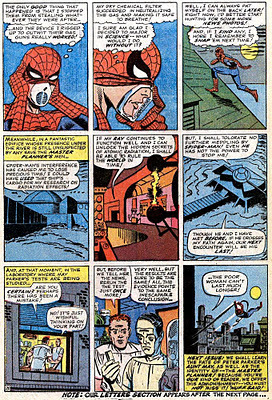 Stan was amazing. He had range. He was able to get me just as worried about Aunt May's illness as he did about the coming of Galactus.
Stan was amazing. He had range. He was able to get me just as worried about Aunt May's illness as he did about the coming of Galactus. It's a good thing. He didn't offer a title for issue #32 and the next issue blurb admonishment "You must not miss it! 'Nuff said!" is right up there with the lamest of all time.
If he had given the title of the next chapter, "Man on a Rampage!" I think that would have sold me all by itself.
But, as you see, other than for the usual problems he's aware of, Spider-Man is hale and hearty. There is no intense, immediate, hero-in-peril cliffhanger.
Next issue blurb dramatizations are not limited to panels or sequences at the end, of course. Well-crafted panels or sequences not directly involved with or critical to the main story in the issue somewhere in the middle can be just as effective. The key term is "well-crafted." If it's good, clear and comprehensible as a portent of things about to happen that relate to the main story, it's a tease. If it's one of those what's-this-and-what's-it-got-to-do-with-anything? confusing bits, it's bad writing.
NEXT: Long Term Teases, or This Better Be Good….
Published on November 02, 2011 13:28
November 1, 2011
How to Do Continued Stories and Next or Future Issue Teases – Part 1
Continued Stories
I was taught that if a story continues in the next issue, end with a climactic cliffhanger.
Well, duh….
And yet….
And, as I learned on my own, that "rule," taught to me by Mort Weisinger, like pretty much all rules applied to creative work, is far from absolute. There are plenty of ways to go about continued stories. More on that later.
But first, the end-with-a-climax/cliffhanger way:
In the first issue, introduce the characters and establish their situation. Introduce the problem, threat, opportunity, whatever that generates the conflict. Develop the conflict to an intense climax/cliffhanger, and end there.
Second issue, elegantly, succinctly introduce the characters. Re-establish the climax/cliffhanger situation from the end of last issue. If possible, intensify the situation. Resolve the climax/cliffhanger—that is, brilliantly get Batman out of the death trap or whatever. Do it in such a way that A) the overall conflict is not resolved but is in fact increased, or B) a related-but-new, greater conflict arises to succeed the resolved conflict. Develop that new or increased conflict to an intense climax and bring the story to a resolution.
Or, you can end with another climax/cliffhanger and continue the story into a third issue.
And a fourth? Or more? There are no rules. But, you'd better be good if you're going to continue a story that way for many issues. Keeping the dramatic tension building over many issues is difficult. And, the longer you make the audience wait, the bigger and better you're going to have to make the final payoff.
The above is not a formula, by the way. No, I am not advocating formula writing. First of all, introducing the characters, establishing their situation, etc.—those are just elements of a story. Any story. Every story. Every Shakespeare play, every episode of Lavern and Shirley, every Michael Crichton novel, every Fleischer Popeye cartoon...etc. Hard to have a story without 'em. They're just the bricks. You can build a cute little Lego shanty out of them or the Taj Mahal. My Mother the Car or Hamlet. No limits.
And the technique of building to a climax/cliffhanger is just that, a technique. It's the most often-used technique. How many times have you seen it done on TV when a show has a two-part episode?
And, by the way, it's generally good policy to try to seamlessly weave your introductions and establishments the info into the action so it's invisible exposition. And provide only the info necessary to understand the story in hand. I have to add that or some people assume that I'm advocating starting every story with a documentary about Spider-Man or whomever.
And, let me add, just in case, of course you continue to introduce/establish characters and what have you throughout the story. Uncle Scrooge is a miser every time you see him, not just the first time.
Get the feeling that what I say has been misconstrued a lot? There's no end of examples out there of people repeating my supposed advice completely wrong.
Anyway….
Another approach to a story that continues over several (or many) issues is to construct each issue as a complete story, each story being a part of the tapestry of the overarching story. No cliffhangers. Just strong, one-issue, related stories adding up to a bigger story.
I used that approach for Steel Nation, a Magnus Robot Fighter story published by VALIANT. Steel Nation consists of four issues. Collectively, they tell the tale of a rebellion of freewill robots against humankind. Each issue has a complete story devoted to a phase of the war, and to the evolution Magnus undergoes as his eyes are opened to the justice of the robots' cause. The stories are entitled "Protector," "Soldier," "Traitor" and "Savior," which should give you a hint about the hero's journey.
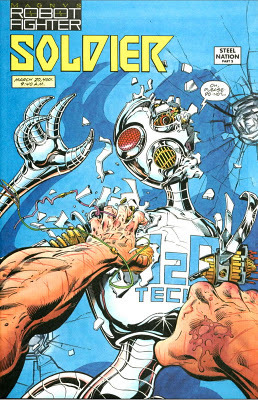 Later, a prequel, "Emancipator" was added.
Later, a prequel, "Emancipator" was added. As I said, there were no cliffhangers, though I did use teasers, especially important with that approach. Stay tuned.
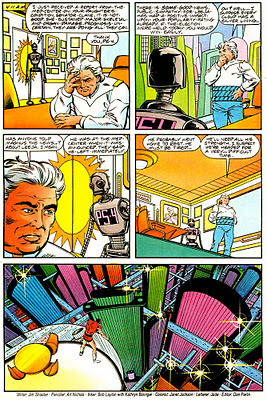 Another approach to continued stories that you don't see much in comics is the Hill Street Blues technique. Hill Street Blues was a TV show about cops. As I recall, in each episode, they started at least one storyline concerning one or more characters, they had the climax/conclusion of a storyline concerning other characters, and they had a "middle" of yet another storyline. Something started, something finished and something was in mid-development every week. And they kept it rolling that way.
Another approach to continued stories that you don't see much in comics is the Hill Street Blues technique. Hill Street Blues was a TV show about cops. As I recall, in each episode, they started at least one storyline concerning one or more characters, they had the climax/conclusion of a storyline concerning other characters, and they had a "middle" of yet another storyline. Something started, something finished and something was in mid-development every week. And they kept it rolling that way.Naturally, that technique is best suited for a group or ensemble.
Doesn't have to be three stories lapping. Could be two or as many as in a Russian novel. But that's a very high-degree-of-difficulty dive. Chris Claremont wandered off into Russian novel-like territory sometimes on X-Men.
Any more?
Sure. Run a continuing story intertwined with complete episodes of other stories. For instance, Green Lantern is involved in a multi-issue pursuit of Sinestro, but in each issue also deals with a villain du jour in a complete story—Star Sapphire one issue, Myrwhydden the next, etc.
Or, as Moench did with his best Master of Kung Fu story, a six-parter, issues #45-50 plus an epilogue issue, I think—he built each issue around the star and one principal member of the supporting cast as the overarching story developed, each issue teeing up the next.
Or Christopher Priest's great Quantum and Woody blackout sketch technique, which told their tale over many issues in bits and bites from all over their lives.
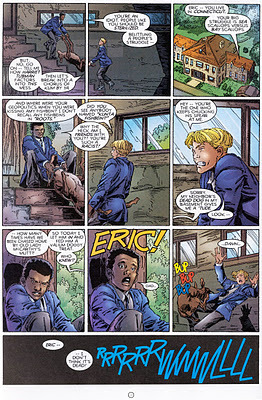 Many other ways, including combinations of the above.
Many other ways, including combinations of the above. One of the great things about a serial medium is that you can do stories bigger than will fit in one issue. Getting readers to come back for the next issue is the challenge.
Not us. We'll be back anyway, because we love this stuff, love the characters and it takes a great deal of awful to drive us away. But the new readers, and those on the fence? Them.
Or any general audience, less hooked on whatever than we are on comics. TV viewers, for instance. Yes, there are some people who will not miss and episode of Law and Order. Yes some shows survived and succeeded because of a dedicated fan base, famously Star Trek. But even the producers of Star Trek made the effort to reach and hold onto new people. That's why the climax/cliffhanger technique is so popular. It's effective.
But, for something that sounds simple and self-evident, in comics it's often not done well.
I've seen this too many times: The writer takes us through twenty-one pages of set-up, what he or she thinks of as "human interest," like hanging around the mansion drinking coffee, and maybe an action scene that's trumped up so there will be an action scene. The hero stops a bank robbery or something. Something ultimately irrelevant to the overarching story. Then, on page twenty-two, Doctor Doom or some villain appears. Doesn't do anything, just appears, looking menacing.
We get it. We know who Doctor Doom is. We know that this means trouble. And we probably didn't mind spending a quiet day with the hero.
But the guy on the fence, or the new reader isn't nearly as impressed, even if they know, or have an idea who Doctor Doom is, or intuit from his looks that he's trouble. What it means to them is that they sat down to read a story, this issue—but, apparently the cool stuff starts next issue.
It's not a cliffhanger. It's a tease. And if what a new reader has paid four bucks for is twenty-one pages leading up only to a tease, there's a fair chance they won't have enjoyed the experience. Not nearly as much as we do, anyway. You know us. We enjoy Spider-Man stopping a miscellaneous bank robbery any old time.
The other way writers in these decompressed days blow it, in my opinion, is that they use a "shocking development" as if it were a climax/cliffhanger. To take a recent example, at the end of Ultimate Comics All-New Spider-Man #2, the shocking development used is that all-new Spider-Man Miles Morales discovers he can stick to walls. [image error]
I wasn't really shocked.
Lots of us enjoy the discovery of whatever Miles' spider powers are being played out. Is the shocking revelation that the new Spider-Man can stick to walls enough to entice a new reader to come back?
Well, who knows? The art is nice.
Once more, with feeling. There is no one way, no "right" way to go about a continuing story. But, as with any commercial endeavor, there are goals. Goals give us a yardstick with which to measure the efficacy of the effort.
You can't argue with empirical evidence. One may criticize the writing on Star Wars IV, or the butchery that took place in the cutting room, but they got the job done, didn't they? The many strengths overcame the weaknesses, like Biggs Darklighter's death having less meaning because the earlier scene of him with best friend Luke was cut. (NOTE: I'm citing that from memory. It was 33 years ago that I read the screenplay. So feel free to correct me, SW-o-philes.
The comics biz at present is succeeding somewhat less well. It's especially troubling because of that nagging feeling that we're letting the ship go down without firing all our guns.
TOMORROW: The Art of the Tease
 No, not that kind.
No, not that kind.TOMORROW: The Best Cliffhanger Ever and Baiting the Hook
Published on November 01, 2011 11:15
October 30, 2011
My Final and Eeriest October Tale
Dire Premonitions
Sometime in early February of 2001, in the middle of the night, I woke up from an intense dream. I dreamed that my father was gravely ill.
Dying.
Just a dream, I told myself.
It became a recurring dream. It happened five more times before March 14th, my mother's birthday.
I hadn't been keeping in touch the family back in Pittsburgh much, hadn't been home to visit for a while. Long story there. But I called my mother on her birthday, of course.
Fateful Phone Conversation
While I was on the phone with my mother, in the background I heard my father grumbling to himself about stomach pains. "I hurt," he said.
My father, Kenneth Shooter, was a man in the way you were supposed to be a man in his generation. I knew of many times when he'd been hurting. I'd never heard him admit it.
It was troubling enough so that I e-mailed my brother-in-law and my cousin, the two most responsible relatives I had who lived in the Pittsburgh area. I told them that they should get my father to a doctor, pronto.
The next morning, I got an e-mail from my brother-in-law saying that Ken was an old guy, old guys normally had aches and pains, and I was making a mountain out of a speed bump.
I replied that I was only eight hours away, if he didn't get Ken to a doctor that day, I was coming there and whether or not Ken was sick would be the least of his problems.
My sister and brother-in law took Ken to a doctor.
He was diagnosed with pancreatic cancer.
Death Sentence
The doctors offered no hope.
He was no quitter. The doctors sort of humored my father's will to fight but didn't try too hard. They surrendered the first day.
I think he lived longer than expected on willpower alone.
My father was a WWII vet. Second wave at Omaha Beach. Awarded a Bronze Star (should have been the Medal of Honor, in my opinion). Awarded the Purple Heart for the serious gashes ripped into his flesh by a grenade. That didn't stop him. He kept going.
Eventually, a bullet shattered the barrel of his carbine, scattering barrel-shrapnel through his guts. That did stop him, for a while, anyway. It got him a trip back to England on a stretcher plus an oak leaf cluster to go with the Purple Heart.
The doctor showed me his x-rays. All throughout his midsection you could see little bits of metal, pieces of grenade and gun barrel still there 56 years later.
He was so angry about the terrorist attacks on 9/11 that he wanted to get out of his hospice bed, get his shotgun and go after bin Laden. Sane people wouldn't let him get up, but I think patriotic adrenaline kept him alive an extra six days.
He died on September 17, 2001.
During those last few months of his life, we became closer than we had in all the years before. He needed someone he could talk to, and by virtue of keeping my cool and remaining rational, I was elected.
I didn't make it to Pittsburgh in time the day he died, but that was okay. The whole seven months of his ordeal was our good-bye.
 Ken Shooter, 19
Ken Shooter, 19Where's the Whetstone?
My mother couldn't maintain the house by herself. I helped her pack up, sell the place and move to an apartment.
My father's workshop occupied the garage. I decided to sell most of the tools, but keep those that had been my grandfather's, my great grandfather's and a few others that I remembered using with my father when I was a kid.
I found everything I wanted to keep—except for a whetstone. It had an unusual shape, sort of like an ironing board. My father taught me how to sharpen blades on that whetstone.
I looked everywhere. I went through that shop carefully, methodically, starting at the cellar door and working my way, literally inch by inch all around. I searched for hours.
No luck.
I sat down on a toolbox. I couldn't believe the whetstone was just gone. He wouldn't have given it away or gotten rid of it. I was totally frustrated.
I said aloud, "Pops, I can't find it. You're going to have to tell me where it is."
And suddenly I knew just where it was.
I stood up, walked to the far right end of the workbench I'd been all over a hundred times, without hesitation or doubt slid open a little secret compartment. There was the whetstone, along with a few screwdrivers of great grandpa's.
The little compartment was ingeniously disguised. The sliding lid appeared to be screwed into place. No way anybody would suspect that board moved. No way anybody would suspect the compartment was there.
Why would he build a secret compartment anyway? To hold a whetstone and some small tools? There were plenty of more valuable items right out in the open.
My father built that workbench after I had moved away from home. I had no knowledge of the existence of a secret compartment. I had never so much as touched that bench during all the years it stood there. No reason to.
Here's a look at the workshop before I started packing: [image error] Ken's workshop. Click to enlarge.
Here's the whetstone:
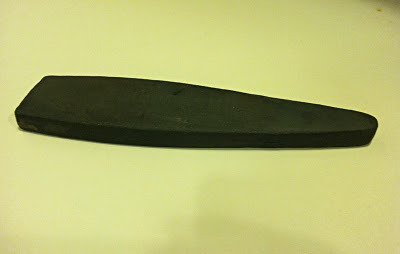
It was ten years ago today that I found the whetstone.
I'll say it again—I don't believe in things supernatural. But strange, inexplicable things happen. Therefore, I am very open minded about such things. However I found, or was guided to the whetstone is mysterious to me.
The story above is absolutely true, and told exactly as it happened.
MONDAY: How to Do Continued Stories and Next or Future Issue Teases
Published on October 30, 2011 21:01
October 28, 2011
The Anti Gravity Room with Broadway Comics
JayJay Here. Back when Jim and I were working on Broadway Comics a Canadian TV show called The Anti Gravity Room came to film a segment with us. The episode is about how comics are made. I found an old video tape of the show a while back and got it transferred to DVD. It has Rob Liefeld and Ty Templeton. Jim and I are in the middle part (Part 2) of the show. The last part has an interesting bit about how comics are printed.
One little personal aside... the day they filmed this I met and ended up dating the cute sound guy who was working on the show. I later talked him into doing a film he'd been offered called Chasing Amy , though he hadn't heard of Kevin Smith, and I went down to New Jersey to be an extra in one of the convention scenes! I couldn't get our Broadway Comics booth to bring since it was being shipped to a real convention, but I borrowed David and Maria Lapham's Stray Bullets banner and "worked" the booth in the scene. One more connection... I made friends with another extra on the set, an indi comic book guy named Mike Mongillo, who has become an independent film director and I've worked on two of his films, Being Michael Madsen and Welcome to Earth , and designed his web site.
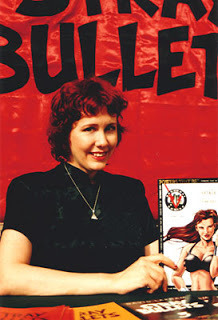
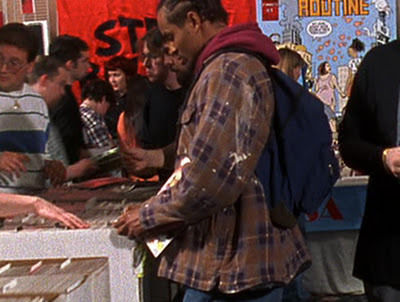 My moment of fame.
My moment of fame.
OVER THE WEEKEND: My Final, and Most Intense October Tale
One little personal aside... the day they filmed this I met and ended up dating the cute sound guy who was working on the show. I later talked him into doing a film he'd been offered called Chasing Amy , though he hadn't heard of Kevin Smith, and I went down to New Jersey to be an extra in one of the convention scenes! I couldn't get our Broadway Comics booth to bring since it was being shipped to a real convention, but I borrowed David and Maria Lapham's Stray Bullets banner and "worked" the booth in the scene. One more connection... I made friends with another extra on the set, an indi comic book guy named Mike Mongillo, who has become an independent film director and I've worked on two of his films, Being Michael Madsen and Welcome to Earth , and designed his web site.

 My moment of fame.
My moment of fame. OVER THE WEEKEND: My Final, and Most Intense October Tale
Published on October 28, 2011 09:01
October 27, 2011
Superman Syndicated Strips
Published on October 27, 2011 20:23
More Tales to Astonish
Stan, Stan the Music Man
George Roussos, who was Marvel's staff cover colorist during the time I was Editor in Chief of Marvel told me something about Stan. I told a tale involving George a while back which can be found HERE.
George was a notable artist, and especially notable as an inker in his younger days. He worked for several companies, among them Marvel-precursor Timely Comics.
Stanley Lieber (who then used the pseudonym "Stan Lee," which later became his legal name), a sixteen-year-old, comics-fanatic kid hired by his "Uncle" Martin Goodman (actually his cousin's husband) was the entire editor of Timely comics.
Stan reportedly was always the first to arrive at the office. George was also an early bird. George told me that, occasionally, when he'd come some mornings to deliver work to Timely in the early forties, the only one there was Stan…
"…sitting cross-legged atop a tall filing cabinet playing the recorder."
Now, there's an image for you.
George's Office
When I first became Editor in Chief of Marvel, George Roussos was the "cover colorist." His office was a tiny, ugly little room at the 575 Mad Ave HQ with no natural light, way in the back near "Stan's Closet," which deserves a post of its own sometime soon.
After early struggles, we turned around the plunge into the abyss I inherited and Marvel started to succeed. Sales were good. We expanded. We had to hire more editors.
I needed George's room, however crummy, for editorial types.
Aha! The perfect solution presented itself. There was a big, well-lit, corner office that, as I recall, had only two occupants, graphic designers, Davida and Nora. Lots of room. Natural light. Quiet co-workers. Perfect, one would think, for a colorist.
I moved George to the "good" room and installed new magazine editor Lynn Graeme in George's old room. Natural light, I figured, was less important for her and her assistant.
George, the good soldier type did as ordered. But he seemed unhappy.
Production manager Danny Crespi clued me in. George had grown up in an orphanage. He'd never had his own space, never had any privacy at all growing up. He hated being in a room with other people. Nothing against them, but he cherished being alone.
Not too long thereafter, Marvel moved to custom-made offices at 387 Park Avenue South. I had some influence (not enough!) on the design. One thing I noticed in the original design was that the architect had put George in the bullpen, with lots of people around him. I objected.
I suggested that we take the planned closet next to the Stat Room and make it George's office.
The architect and others involved, financial officer and, for all intents and purposes, operations V.P., Barry Kaplan argued that A) it was a closet! It was tiny! And B) I was insane. I conceded "B," but pointed out that, because the closet was next to the stat room, which required water, there was no reason it couldn't have a sink! Vital to a colorist. And I assured them that George would be happy there.
I won!
We moved in. George was pleased with his new "office." He actually made it smaller, sort of. He put his art table in one corner, walled himself off with tall filing cabinets, kept the lights off except for the desk lamp over his table and was happy as a clam.
Not a day went by that George didn't thank me for his office.
My remembrance of George's office (many fond memories). - JayJay

Items Possibly of Interest
Here are a few things that relate to previous posts and comments:
A memo regarding the Olshevsky Marvel Indexes:

 [image error]
Marvel office alleged humor, Lynn's joke memo and an anonymous response:
[image error]
[image error]
Marvel office alleged humor, Lynn's joke memo and an anonymous response:
[image error]
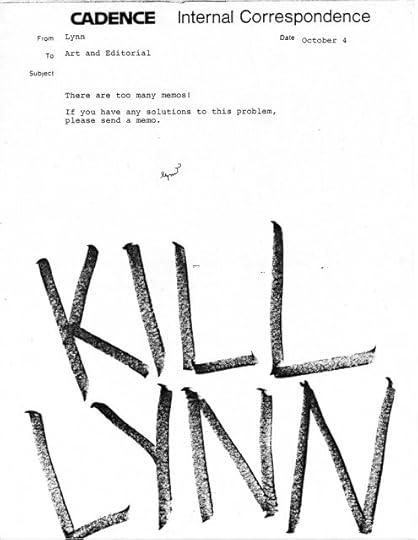 One of Bob Budiansky's Transformers character developments:
[image error]
One of Bob Budiansky's Transformers character developments:
[image error]
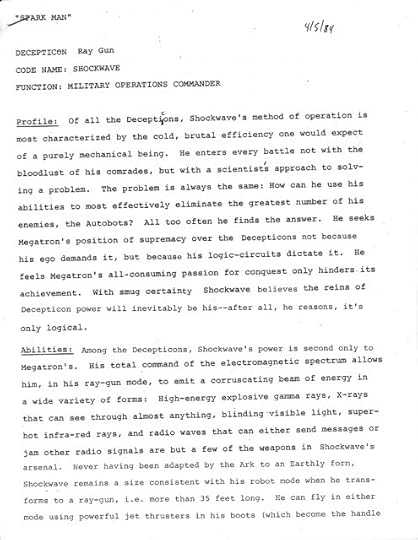
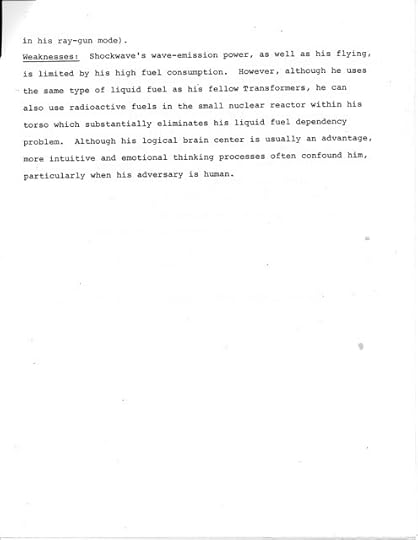 A memo about X-Factor early on:
A memo about X-Factor early on:
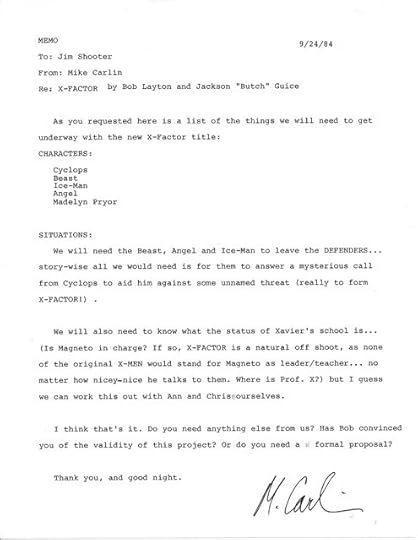 The "Continuity Bonus" plan:
The "Continuity Bonus" plan:
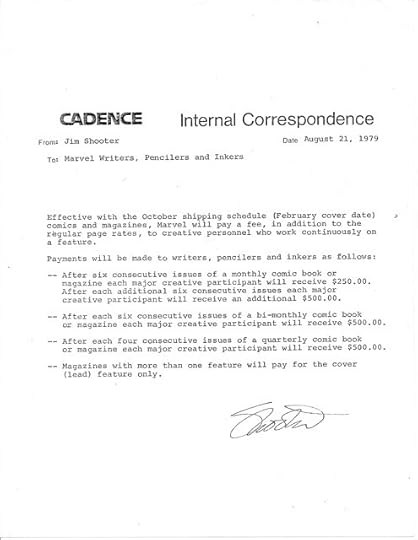 The script for a "Spider-Man's Bachelor Party" event. Not sure who wrote it. The last line sounds like me, but…not sure:
[image error]
The script for a "Spider-Man's Bachelor Party" event. Not sure who wrote it. The last line sounds like me, but…not sure:
[image error]

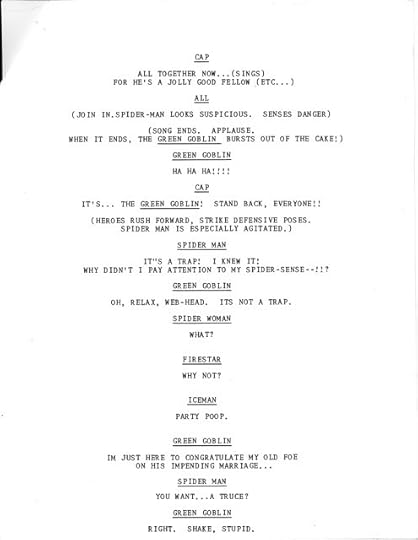
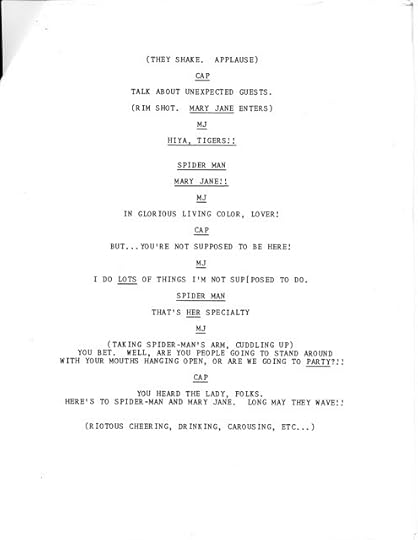 TOMORROW: Another surprise from the archives - JayJay
TOMORROW: Another surprise from the archives - JayJay
OVER THE WEEKEND: My Final, and Most Intense October Tale
MONDAY: I Don't Know! I'll Come Up With Something!
Published on October 27, 2011 18:02
October 26, 2011
SUPERMAN – First Marvel Issue – Comments on Byrne's Plot
When it seemed that Marvel might get the rights to Superman, John Byrne wrote an eight-page proposed plot for the first issue. My beat-by-beat description of Byrne's plot yesterday generated a wave of very interesting, very insightful comments, among them these:
Marc Miyake said...
Dear Jim,
Thanks for summarizing Byrne's plot. I wish you had reviewed it, but maybe it's best that you didn't because we readers can then give our own evaluations without being influenced.
I wasn't terribly fond of much of Byrne's published revamp, but in some ways I prefer it to this unused plot:
1. The "searing radiation": This element is confusing and unnecessary. Could Lara have been poisoned by it? Maybe not, since Kal-El wasn't. Did it mutate them, just as cosmic rays changed the Fantastic Four? Whatever changes affected Lara -- if any -- obviously weren't enough to enable her to survive the crash ... despite Jor-El's prediction that the "additional factor [...] that will help them [plural!] survive." Maybe Byrne meant to introduce the "additional factor" in some later issue.
2. Lara dying on Earth. Byrne has mentioned this in an earlier proposal. This serves no purpose I can see other than to differentiate this origin from the classic one in which Jor-El and Lara die as a couple. I recall Byrne saying that Lara's death would serve a purpose: she'd die from kryptonite and thereby prove that it was fatal. Maybe he came up with that after he turned in this plot.
3. Martha's "pregnancy": IIRC, in the published revamp, Martha had a cover story: she was pregnant when the Kents were snowed in (sorry if I got this wrong). No cover story here.
4. Jonathan's death: In the late 30s version of the origin, the passing of both Kents marks Clark's manhood. This death just seems random. I guess Martha has to survive to sew Clark's costume.
5. The raid reminds me of Spider-Man's origin: in both case, a failure to act led to terrible consequences. Would Byrne's Superman have been perpetually haunted by this incident? Was this a conscious attempt to Marvelize Superman, to give him a psychological weak point? I don't like the idea of associating Superman with failure.
6. The subway rescue is large in scale, but not as spectacular as the space plane rescue in the published revamp.
It's still a decent done-in-one, though. I'm sure I'd have loved Byrne's art, and the conclusion cracked me up: "Sorry, the caped man says, he's already given his story to someone else, Clark Kent." And I'm relieved to see that teenage Clark didn't become a football star which I've long thought was out of character. (Maybe he did off-panel.)
I wonder how readers who have read the New 52 relaunches of the Superman titles would react to this plot.
(…)
October 25, 2011 5:48 PM
Ben Ronning said...
Dear Jim,
I remember hearing rumor that claimed John Byrne wanted Lara to give birth or Kal-El on Earth (and thus make him a native of Earth in a roundabout fashion) and this pitch confirms it. It would have been interesting to see the fan reaction if this agreement went through. Would other DC characters like Batman, Wonder Woman, and Green Lantern (among others) have gotten a similar "reboot"?
October 25, 2011 5:51 PM
Ben's question got this reply from me:
jimshooter said...
Dear Ben,
Byrne wrote his plot for the potential first Marvel issue of Superman without being asked. I wouldn't have accepted his plot. I have significant, fundamental problems with it. His take on Superman was just that, his take, not at all what Marvel would have done under my watch.
There would have been a relaunch of all the characters, and some things, of necessity, would have been changed. The reboots would have not been "similar" to what Byrne proposed for Superman.
October 25, 2011 6:37 PM
Which inspired this from Marc:
Marc Miyake said...
Dear Jim,
Could you briefly describe the "significant, fundamental problems" you have with the plot? I'm interested in your take on its mechanics.
Maybe I'm so tired of structureless and/or incomprehensible "stories" that I'm relieved to see a comprehensive story with structure, even if it has elements that just ... exist without much impact: e.g.,
- Lara's death (she might as well have died on Krypton and the story would still be the same)
- Jonathan's death (no visible effects on Clark; cf. the impact of Uncle Ben's murder on Peter Parker)
Also, what sorts of things about the DC characters would have to change in the revamps beyond simply restarting continuity from zero? Did you think some elements in their concepts and backstories were dated and/or somehow out of sync with 1980s Marvel standards?
For those familiar with Byrne's published revamp:
By coincidence, I happen to have The Man of Steel #1 (1986) and Marvel Masterworks: The Amazing Spider-Man Vol. 1 by my side right now for reasons unrelated to this post and it occurred to me that both Superman and Spider-Man publicly debut saving spacecraft.
October 25, 2011 7:26 PM
This was my answer:
jimshooter said...
Dear Marc,
Briefly, Marc, it's a history, not a story. More documentary than drama.
If Marvel had relaunched the DC titles we would have made them work together as a universe. We would have started with the core concepts, everything that was good about/important to the characters and started from there. Changes and updates would have been made carefully and only as necessary.
Byrne didn't do that in this plot.
October 25, 2011 10:58 PM
Later, this came in:
Craig Hansen said...
It's interesting to see what Byrne's plot consisted of. It's the opposite of decompression, for sure.
That said, I saw a lot of problems with it even before reading the comments section and Jim's remarks.
While there is room for criticism of Byrne's choices, both here and what he actually had published later on, I must say this:
Imagine having the kahunas to actually tackle a project like this!
Even back in the mid-80s or so when it happened, Supes had been around for something like fifty years. Now it's closer to eighty.
And he's the first superhero, a cultural icon and even the mildest changes ever made to him have caused people to trample baby seals in outrage, and use chihuahuas as boomerangs!
(Okay, maybe not, but close to it.)
Yet Byrne did it. He laid his kahunas on the table, knowing a lot of people were standing around with machetes, and said, "Here it is, here's my take, it's probably not perfect but nothing is, and this is the best I can do with it."
I was briefly contemplating a post saying, "Byrne's plot sucked, here's how I'd do it."
But really.... as I thought about doing that... it overwhelmed me a bit. Even though it's just Jim and his followers.
I mean, to redo anything and call it Superman... that's just huge.
One would almost be better off using those changes on an all-new, different character, rather than one as iconic as Supes.
Are there plot holes in Byrne's plot? Sure. But I trust Jim and John would have hashed them out before anything was drawn, had it ever happened.
(…)
October 26, 2011 6:52 AMThe last line quoted above got me thinking…would Byrne and I have hashed out the problems I have with the plot?
I'd like to think so.
I never discussed the plot with him back then because there was no need to. When he gave it to me, the deal with Warner Communications was not yet consummated and, shortly thereafter, the deal died. As explained previously, around that time, First Comics sued Marvel on anti-trust grounds, which rendered swallowing up our largest competitor a non-starter.
As stated above, I think that John's first attempt at an issue #1 plot feels more like a history than a story. It's a long and winding road leading up to a villain showing up on the last page. Not doing anything—just showing up.
Think of the difference between seeing a film documentary about a German soldier during World War I as opposed to seeing All Quiet on the Western Front.
I also think that some of the changes John made unnecessarily strayed from canon, and some of his changes would have caused more problems than they solved. Lara's body being on Earth, for instance. No mention of her body after she dies in the plot, but we, and her son, I'd think, would want to know at some point what was done with it, and depending on what was done there would be different ramifications.
What JediJones said cracked me up:
JediJones said...
(…)
The biggest problem with that for me as Jim alluded to is wondering what happens to Lara's body? It adds an unnecessarily creepy and alien note to the Superman myth to think that his Kryptonian mother is buried somewhere on earth. You'd have to be reminded of it many times because he would naturally want to visit her grave. It also makes the Kents a little too aware of his alien origins. On an emotional level, it badly mars the joyous moment of Kal-El's arrival on earth and the Kents' discovery of him. Perhaps even worse, it would have been too tempting for later writers to build a plot around some villain exhuming her body or dissecting it. She probably would have ended up as one of those "Blackest Night" zombies.
October 25, 2011 8:48 PM
A super-zombie! Good grief!I have doubts about the "aura" that protects his clothing, more so the closer it is to the body, which was John's way of explaining the need for the skintight costume. But, what about the cape? Can we expect to routinely see that in tatters?
I have various other problems with the logic and mechanics as presented.
Wouldn't almost anyone report someone dying in front of them to proper authorities…? Even given the weird circumstances of Lara's death?
Would upstanding citizens, described by John as "…standard issue rustics, American Gothic types, salt of the earth and try (sic) believers in those things that made, and make this country great," somehow clandestinely dispose of Lara's body, somehow, apparently, hide the wreckage of a spaceship (!) and simply assume custody of the baby? And go as far as to create the unlikely cover story that fifty-something Martha Kent got pregnant (!) and kept it secret. No mention in the plot of anyone so much as being a little curious or suspicious of this highly unusual pregnancy, conveniently hidden. Wouldn't someone suspect that the baby wasn't hers? No, not per the plot.
The foundling child who grew up to be the Superman I read about in the 50's and wrote in the 60's had been turned over to authorities by the Kents and later was legally adopted by them. There was no body to be disposed of, and if I remember right, Jonathan kept the small ship in a shed. That seemed to work.
It's also hard to believe also that it never occurred to Clark before the raid to rescue the President that he might be able to do a lot of good with his powers. It is clear in the plot that it occurred to Martha Kent many years earlier. How dumb is this guy?
Anyway….
I had no particular plot in mind for the first Marvel issue of Superman. I had some ideas about things that could be done with the various characters, but nothing graven in stone, and nothing in the way of specific stories or plots. I was open to anything good, that worked.
All I really had for sure were the guiding principles of sorts stated previously: the titles would have to work together as a universe, we would stick to the core concepts as much as possible/practical, and changes and updates would be made carefully.
To that I'll add that the stories ought to be good stories, that the #1's especially ought to be wonderful, powerful, definitive stories.
So, if John was committed to his proposed plot as written, then, sadly, we would have had to get other creators. But if John had been willing to discuss the story, I think I would have been able to help him make it better. Possibly, he would have talked me into some of his ideas.
I was dead set against Phoenix coming back and several people, principally John, talked me into that. I'm not nearly as difficult to reason with as some allege.
John might have been willing to talk. He was enthused enough about writing and drawing Superman to write a plot on spec. It must have been important to him. Maybe he would have been willing to accept input.
In those days, at least as far as I knew, John and I got along well enough. Creators disgruntled about this or that here and there is normal in any operation where there's a boss who sometimes says no. It's background radiation. I don't know exactly when all his animosity toward me went into high roentgen levels, but at that time it didn't seem as toxic.
I've never had animosity toward John. When I saw him a few years ago when both of us were witnesses at a hearing, I offered my hand. He stared at my outstretched hand for a few seconds, then said, "Only because we're temporarily on the same side (of the case pending)," and shook my hand.
Okay….
Whatever.
John is one of the most talented people I've ever been around, and I've been around a Hell of a lot of comics Hall-of-Famers and great creators outside of comics. He's brilliant. Doesn't mean he's perfect, or that he gets it right the first time every time.
We hadn't spoken about what my intentions for the potential new DC universe were. He couldn't possibly have known all the parameters I had in mind.
He took a shot in the dark, and in my opinion, missed.
Maybe you like my opinion, maybe you don't, but at the time, I had Stan Lee's old job, and my opinion was the governing one.
If John and I had talked about the story, I believe we would have worked out the disagreements. I suspect he would have nailed it.
And wouldn't the art have been nice….
NEXT: Really, More Tales to Astonish
Published on October 26, 2011 15:12
Marvel Layoffs - 1996
JayJay here. Jim is taking care of other business today so I found another old news article for you. I thought it was an interesting aspect of Marvel history in the wake of some of Marvels' most recent layoffs.



Published on October 26, 2011 10:00
Jim Shooter's Blog
- Jim Shooter's profile
- 85 followers
Jim Shooter isn't a Goodreads Author
(yet),
but they
do have a blog,
so here are some recent posts imported from
their feed.


